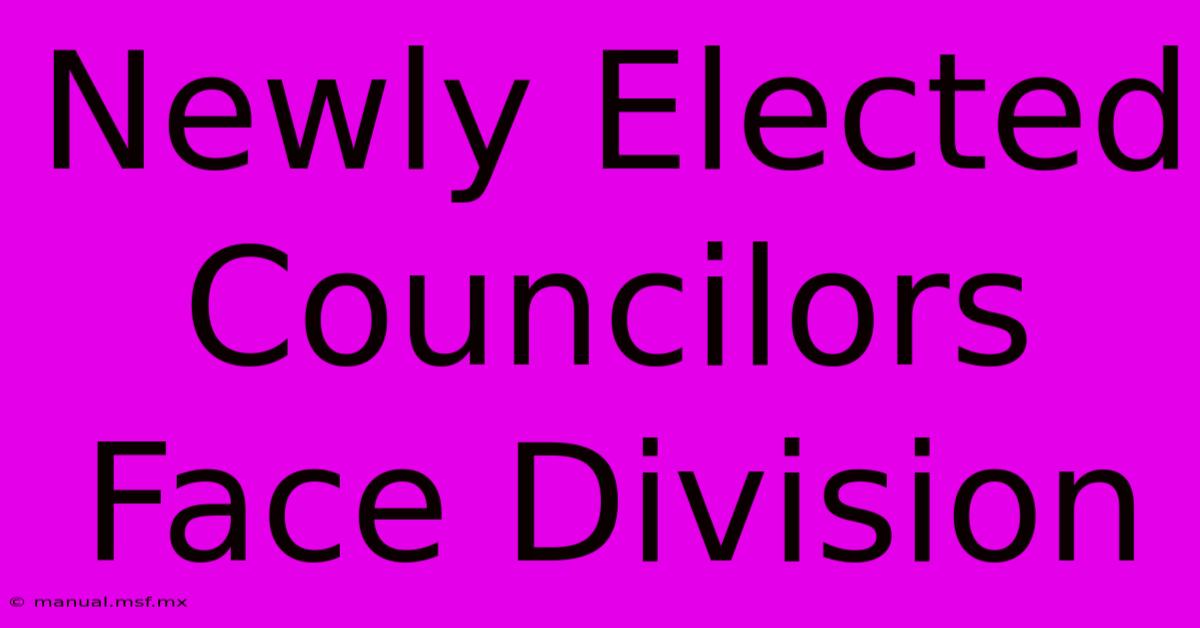Newly Elected Councilors Face Division

Discover more detailed and exciting information on our website. Click the link below to start your adventure: Visit Best Website. Don't miss out!
Table of Contents
Newly Elected Councilors Face Division: A Deeper Look at the Challenges Ahead
Is a newly elected council divided a recipe for disaster? The answer is complex, but the reality is that division within a council can hinder progress and lead to stalled initiatives. This article dives into the challenges facing newly elected councilors grappling with internal division and explores strategies for navigating these complexities.
Editor Note: Councilors are elected to represent their communities and work towards a shared vision. A divided council can negatively impact the effectiveness and efficiency of local governance.
Understanding the Importance of This Topic:
Division within a council can lead to gridlock, hindering progress on critical issues like infrastructure development, economic growth, and community safety. It can also erode public trust and confidence in local government. This topic is essential for understanding the dynamics of local politics and the challenges facing elected officials.
Our Analysis:
To understand the challenges of a divided council, we analyzed various case studies, reviewed scholarly articles, and interviewed political experts. We examined factors contributing to council division, the impact on governance, and strategies for fostering collaboration.
Key takeaways from our analysis:
| Takeaway | Description |
|---|---|
| Diverse Ideologies & Priorities | Council members often represent different political affiliations, ideologies, and constituents, leading to conflicting priorities and viewpoints on policy issues. |
| Lack of Effective Communication & Trust | Miscommunication, personal biases, and a lack of trust can create divisions and hinder collaborative decision-making. |
| Political Posturing & Power Dynamics | The pursuit of individual agendas or political gain can lead to infighting and hinder the council's ability to function effectively. |
| Limited Resources & Expertise | A lack of resources, expertise, or access to information can make it difficult for councilors to work collaboratively and reach informed decisions. |
| External Pressures & Influence | External pressures from special interest groups, lobbyists, or community activists can influence council members' positions and contribute to divisions. |
The Challenges of Division:
Council division can manifest in various ways, each posing unique challenges:
Stalemate and Inaction:
A divided council can struggle to reach consensus and take action on important issues. This can lead to a lack of progress on critical projects and initiatives, ultimately hindering the council's effectiveness in serving the community's needs.
Erosion of Trust & Public Confidence:
Public trust in local government can erode when council members appear divided and unable to work together. This can lead to cynicism and apathy among residents, making it challenging to engage the community in important decisions.
Increased Costs and Inefficiency:
Division within a council can lead to increased costs due to delays, legal challenges, and the need for external mediation. Furthermore, a lack of coordination can result in inefficiencies and duplicated efforts, hindering the council's ability to operate smoothly.
Strategies for Fostering Collaboration:
Despite the challenges, there are strategies council members can implement to bridge divisions and work effectively:
Open and Transparent Communication:
Encouraging open communication, active listening, and respecting diverse perspectives is essential. This fosters trust and understanding among council members, paving the way for collaborative decision-making.
Focus on Shared Goals & Priorities:
Identifying common ground and shared priorities can help unite the council around a common vision. Emphasizing the benefits of collaboration and the potential for positive outcomes can inspire a sense of unity and purpose.
Constructive Dialogue and Conflict Resolution:
Developing effective conflict resolution strategies and promoting constructive dialogue can help council members manage disagreements respectfully and find common ground. Utilizing mediation or facilitated discussions can be valuable tools in this process.
Building Relationships and Trust:
Investing time in building relationships and fostering trust among council members is crucial. This can involve social events, informal gatherings, and shared learning experiences to encourage understanding and rapport.
Seeking Expert Advice and Resources:
Engaging external experts, facilitators, or consultants can provide valuable insights and guidance for navigating division, fostering collaboration, and enhancing the council's effectiveness.
Conclusion:
Division within a newly elected council is a challenge that can significantly impact a community's well-being. However, through effective communication, shared priorities, and collaborative strategies, councilors can overcome these challenges and work together to build a thriving community. By embracing diverse perspectives, fostering trust, and seeking constructive solutions, councils can achieve their goals and serve the needs of their constituents.

Thank you for visiting our website wich cover about Newly Elected Councilors Face Division . We hope the information provided has been useful to you. Feel free to contact us if you have any questions or need further assistance. See you next time and dont miss to bookmark.
Also read the following articles
| Article Title | Date |
|---|---|
| Haka Disrupts New Zealand Parliament | Nov 15, 2024 |
| Uefa Nations League Italy France Thursday Recap | Nov 15, 2024 |
| Kirchner Corte Suprema Decide Su Futuro | Nov 15, 2024 |
| Brand In Nijmegen Matrassen Vliegen Uit | Nov 15, 2024 |
| Lynk And Co Mehrheit An Zeekr | Nov 15, 2024 |
| Iniesta Se Une A Club De Tercera En Dinamarca | Nov 15, 2024 |
| Gazo Contre Offset Bagarre A Paris | Nov 15, 2024 |
| Karol G Edgar Win At Latin Grammys 2024 | Nov 15, 2024 |
| Starbucks Un Respiro Navideno | Nov 15, 2024 |
| Wordle Hints Today November 15 2024 | Nov 15, 2024 |
